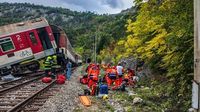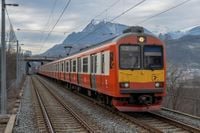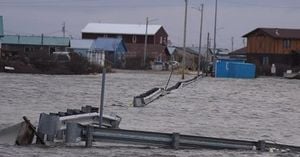On the morning of October 13, 2025, Slovakia was rocked by a devastating train collision that left dozens injured and the nation reeling. The accident, which occurred near the village of Jablonov nad Turňou in eastern Slovakia, involved two express trains—identified as the R 913 and R 914 ‘Gemeran’ services—traveling between Zvolen and Košice. According to Slovak Railways and emergency services, the crash happened just after 10:00 a.m. local time, as the trains approached a section of track that narrows from double to single line, a notorious pinch point in the region's rail infrastructure.
Initial estimates placed the number of passengers on board at about 80, though some reports suggested the figure could be as high as 100. The impact was severe: at least 66 people sustained injuries, with two in critical condition and others suffering moderate to minor trauma. Emergency medical services confirmed that 16 passengers had moderate or serious injuries, while at least 50 were lightly hurt. The collision derailed a locomotive and a carriage, leaving the front of one train badly mangled and another carriage teetering near a ravine—a scene that rescue teams worked feverishly to secure, fearing further collapse.
Images and footage shared by police and local media painted a harrowing picture: mangled wreckage strewn along a hillside, firefighters and paramedics tending to the injured, and a locomotive lying off the tracks. The collision occurred just before a tunnel entrance, which complicated access for emergency crews. According to Reuters, police footage posted to Facebook showed the extent of the devastation, with carriages suspended perilously and rescue workers shoring up the site to prevent further disaster.
Rescue operations were swift and extensive. Multiple helicopters, fire brigades, and ambulance units were dispatched to the scene, while nearby hospitals in Košice and Rožňava activated trauma plans to handle the influx of casualties. Seriously injured passengers were airlifted to hospitals, and first aid was administered on site. Slovak Railways quickly suspended rail services in the area and implemented replacement bus routes to accommodate stranded travelers. The accident also triggered a multi-kilometer traffic jam on the road from Rožňava, forcing police to limit access to the crash site as rescue efforts continued.
The immediate priority, as a Slovak Railways spokesperson stated, was "the rescue and evacuation of passengers and our employees." This sentiment was echoed by Interior Minister Matúš Šutaj Eštok, who arrived at the scene alongside Transport Minister Jozef Ráž. In a press briefing, Eštok reported, "According to preliminary information, this is an extraordinary traffic accident that probably occurred due to human error." He further clarified that one of the train drivers may have failed to yield on the single-track section, a breach of protocol that likely led to the collision.
Prime Minister Robert Fico wasted no time in responding to the tragedy. He ordered a full and thorough investigation, emphasizing the need for clarity before drawing any conclusions. "A thorough investigation must clarify the causes of this tragedy," Fico stated, underscoring the government's commitment to transparency and accountability in the wake of the disaster.
As the investigation unfolded, more details emerged about the circumstances leading up to the crash. Preliminary reports indicated that the collision occurred at a point where the double-track line narrows to a single track—a configuration that inherently increases the risk of accidents if proper signaling and communication are not maintained. Interior Minister Eštok noted that one of the train drivers was abstinent at the time of the crash, while the other, who suffered heavy injuries, was hospitalized and would undergo drug and alcohol testing once stable.
The aftermath of the collision prompted renewed scrutiny of Slovakia's rail safety protocols. Transport safety specialists and officials alike pointed to the urgent need for modernizing the country's signaling systems and introducing automatic train control, especially on single-track sections. As reported by Railway Supply, such upgrades could significantly reduce the likelihood of human error, a factor cited as the probable cause in this incident. Calls for a technical audit of the signaling system and strengthened train traffic control grew louder in the days following the crash.
Despite the severity of the accident, there were no reports of fatalities—a fact that many attribute to the quick response of emergency services and the resilience of the rail carriages. Still, the psychological toll on passengers and the broader public was palpable. Many survivors were left in shock, and the incident reignited concerns about the safety of Slovakia's aging rail infrastructure.
Interestingly, while most reports focused on the eastern Slovakia collision near Jablonov nad Turňou, one account described a separate incident near Petržalka, just outside Bratislava, involving a passenger train colliding with a stationary freight train. However, the overwhelming consensus among official sources and major news outlets centered on the crash near Rožňava, underscoring the confusion and chaos that often accompany large-scale transportation disasters.
In the wake of the accident, local businesses and daily commuters faced significant disruptions. The Bratislava-Košice line, a vital artery for both domestic and international travelers, was brought to a standstill. Replacement bus services were hastily organized, but delays rippled across the region, leaving many stranded or forced to seek alternative routes.
Looking ahead, Slovak authorities have pledged to leave no stone unturned in their investigation. The government has promised a comprehensive review of rail safety measures, including mandatory upgrades to signal systems, more frequent inspections, and the implementation of advanced technologies to detect hazards on the tracks. As the country recovers from this traumatic event, the focus will inevitably shift to ensuring that lessons are learned and that the safety of Slovakia's rail network is strengthened for the future.
The tragic collision near Jablonov nad Turňou stands as a stark reminder of the importance of vigilance, investment, and modernization in public transportation. For the passengers who boarded the trains that morning, ordinary routines were shattered in an instant—a sobering lesson for officials and citizens alike as Slovakia charts a path forward.





